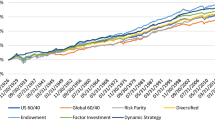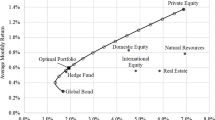Abstract
This paper highlights the long run, strategic benefits of factor premia as a complement (overlay) to an underlying exposure to equities and bonds. We provide a utility-based framework for evaluating alternative strategies and in particular account for the impact of extreme and undesirable events to long run wealth accumulation. We present evidence suggesting that an overlay of equity premia to a reference portfolio can enhance the likelihood of achieving wealth accumulation goals and can smooth the transition path to achieving those goals. These results can be attributed to both long positions and short positions in contrast to recent findings suggesting shorts fail to add value. The benefits of the factor premia overlay additionally extend to the decumulation or retirement stage as reflected in an enhancement to the coverage ratio. Taken together, these findings suggest that the equity factor premia strategies we present can be utilized to support welfare enhancing gains.










Similar content being viewed by others
Notes
For instance, investors may be restricted from shorting and hence may be constrained into a long only exposure to factors.
Intertemporal Capital Asset Pricing Model (ICAPM).
Mean-variance efficient (MVE).
These constructs can be easily implemented with futures. For instance, for $100 of initial investment $10 are used to buy futures on margin providing a notional exposure of $100 to the base asset. The remaining $90 can be invested in a long/short strategy that could exhibit varying leverage; for simplicity we assume the total long/short gross exposure to be either $300 (for the 200/100) or $160 (for the 130/30).
Scott and Cavaglia (2017) provide a more technical motivational and methodological expose of the block bootstrap approach. In their 2017 study they use quarterly data blocks. Our results are not overly sensitive to alternative blocks sizes of up to 12 months. Politis and Romano (1992) and Politis (2003) provide relevant analytical foundations.
The CRRA of 2 has the functional form U = {1-exp(-2w)}/w. The expected utility E(w) can then be used in the inverse function of the CRRA to obtain the CE.
Returns are reported gross of transactions costs and borrow costs; the analysis of Briere et al. (2020) suggests that factor-based strategies can be scaled significantly by effective management of these costs.
The commodity market is proxied by the S&P GSCI index, the equity market is proxied by the MSCI World index, and the bond market is proxied by the World Government Bond index (WGBI).
The ubiquitous equity value premium provides an interesting illustration of our insight. The long only MSCI World value index for the period 1974 to present has not exceeded the return on the market. However, over this same period the Fama-French Long/Short value factor portfolio has returned 2.7% per annum. This has been labelled in the empirical finance literature as the “transfer” loss; in this case it is material.
We are grateful to Alessio De Longis for guiding us through these observations.
These qualitative conclusions hold as well for the 130/30 strategy.
The 130/30 strategies result in much small marginal increases in volatility of 0.03% for equities and 0.06% for bonds.
References
Blay, Kenneth, Anish Gosh, Steven Kusiak, Harry Markowitz, Nicholas Savoulides, and Qi. Zheng. 2020. Multiperiod Portfolio Selection: A Practical Simulation-Based Framework. Journal of Investment Management 18 (4): 94–129.
Blitz, David, Joop Huij, Simon Lansdorp, and Pim van Vliet. 2014. Factor Investing: Long-Only versus Long-Short. SSRN Working Paper. https://dx.doi.org/https://doi.org/10.2139/ssrn.2417221
Briere, Marie, Charles-Albert Lehalle, Tamara Nefedova, and Amine Raboun. 2020. Stock Market Liquidity and the Trading Costs of Asset Pricing Anomalies. SSRN Working Paper. http://dx.doi.org/https://doi.org/10.2139/ssrn.3380239
Cavaglia, Stefano, Louis Scott, Kenneth Blay, and Vincent De Martel. 2021a. Momentum, Value, and Carry Commodity Factors for Multi-Asset Portfolios. In Market Momentum: Theory and Practice, ed. Stephen Satchell and Andrew Grant, 359–386. New York: Wiley.
Cavaglia, Stefano, Vadim Moroz, and Louis Scott. 2021b. Exploiting the Countercyclical Properties of Momentum and other Factor Premia – a Cross Country Perspective. In Market Momentum: Theory and Practice, ed. Stephen Satchell and Andrew Grant, 198–217. New York: Wiley.
Cochrane, John. 1999. Portfolio Advice in a Multifactor World. Federal Reserve Bank of Chicago Economic Perspectives 23: 59–78.
Conine, Thomas, Michael McDonald, and Mauri Tamarkin. 2016. Estimation of Relative Risk Aversion across Time SSRN. Working Paper. http://dx.doi.org/https://doi.org/10.2139/ssrn.3045931
Cuthbertson, Keith, Simon Hayley, Nick Motson, and Dirk Nitzche. 2016. Diversification Returns, Rebalancing Returns and Volatility Pum**. Caas Business School Working Paper. http://dx.doi.org/https://doi.org/10.2139/ssrn.2311240
Das, Sanjiv, Daniel Ostrov, Anand Radhakrishnan, and Deep Srivastav. 2019a. Dynamic Portfolio Allocation in Goals-Based Wealth Management. Santa Clara University Working Paper. http://dx.doi.org/https://doi.org/10.2139/ssrn.3211951
Das, Sanjiv, Daniel Ostrov, Anand Radhakrishnan, and Deep Srivastav. 2019b. A New Approach to Goals Based Wealth Management. Santa Clara University Working Paper. http://dx.doi.org/https://doi.org/10.2139/ssrn.3117765
De Longis, Alessio. 2019. Dynamic Asset Allocation Through the Business Cycle: A Macro Regime Approach, Invesco Investment Solutions Manuscript.
De Longis, Alessio, and Dianne Ellis. 2019. Market Sentiment and the Business Cycle: Identifying Macro Regimes Through Investor Risk Appetite. Invesco Investment Solutions Manuscript
Erb, Claude, and Campbell Harvey. 2006. The Strategic and Tactical Value of Equity Futures. Financial Analyst Journal 62 (2): 69–97.
Estrada, Javier and Mark Kritzman. 2018. Evaluating Retirement Strategies: A Utility Based Approach, SSRN Working Paper. http://dx.doi.org/https://doi.org/10.2139/ssrn.3135125
Fama, Eugene. 1996. Multifactor Efficiency and Multifactor Asset Pricing. Journal of Financial and Quantitative Analysis 31 (4): 441–465.
Polk, Christopher, Mo. Haghbin, and Alessio De Longis. 2020. Time-Series Variation in Factor Premia: The Influence of the Business Cycle. The Journal of Investment Management 18 (1): 218–242.
Politis, D.N. and Joseph P. Romano. 1992. A Circular Block Resampling Procedure for Stationary Data. in Exploring the Limits of Bootstrap, edited by R. LePage and L. Billard, 263-270. New York: John Wiley and Sons.
Politis, D.N. 2003. The Impact of Bootstrap Methods on Time Series Analysis. Statistical Science 18 (2): 219–230.
Raymond, Donald. 2009. Integrating Goals, Structure, and Decision-Making at Canada Pension Plan Investment Board, SSRN Working Paper 1131414.
Scott, Louis, and Stefano Cavaglia. 2017. A Wealth Management Perspective on Factor Premia and the Value of Downside Protection. Journal of Portfolio Management, Spring 2017: 1–9.
Warren, Geoffrey. 2019. Choosing and Using Utility Functions in Forming Portfolios. Financial Analysts Journal 75 (3): 39–69.
Wilcox, Jarrod, Jeffrey Horvitz, and Dan DiBartolomeo. 2006. Investment Management for Taxable Private Investors. The Research Foundation of CFA Institute.
Author information
Authors and Affiliations
Corresponding author
Additional information
Publisher's Note
Springer Nature remains neutral with regard to jurisdictional claims in published maps and institutional affiliations.
This paper was completed prior to Stefano Cavaglia joining SWIB and while he was employed at Virtual Asset Management (VAM), Sydney. The views presented in the paper do not necessarily reflect the views of the State of Wisconsin Investment Board.
Rights and permissions
About this article
Cite this article
Cavaglia, S., Scott, L., Blay, K. et al. Equity factors for multi-asset class portfolios: a strategic asset allocation perspective. J Asset Manag 23, 100–113 (2022). https://doi.org/10.1057/s41260-022-00262-4
Revised:
Accepted:
Published:
Issue Date:
DOI: https://doi.org/10.1057/s41260-022-00262-4




